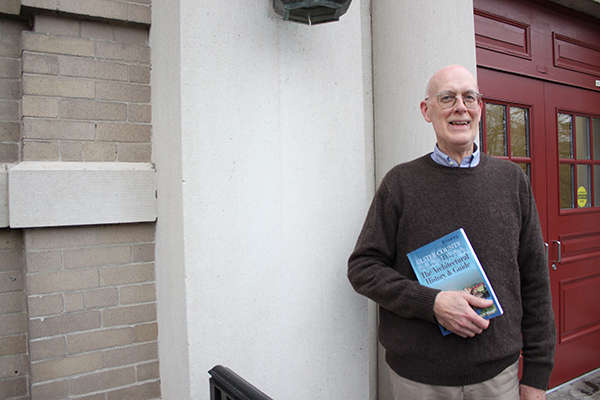

William Rhoads, Emeritus of Art History at SUNY New Paltz, has published his third book, “Ulster County, New York: The Architectural History & Guide” (Black Dome Press), a tour of architecture in the surrounding area.
“I hoped that people would see that interesting, important landmarks can be around in your backyard,” Rhoads said. “It’s good to keep one’s eyes open and be conscious of one’s setting.”
Similar to his previous book, “Kingston, New York: The Architectural Guide” published in 2003 (Black Dome Press), Rhoads’ latest venture features historical buildings and sites. There are 325 sites and 340 illustrations in the guide.
These sites include buildings on the SUNY New Paltz Campus such as College Hall, the Old Library, Hanmer House (Judge A.V. Dayton House) and Old Main (New Paltz Normal School).
Although Rhoads began documenting and photographing the area in 1970, when he first started teaching here, he found that he had more time to invest in studying the architecture around him since he retired in 2005.
“It’s fun to work on buildings that I haven’t really paid much attention to but see every day,” Rhoads said. “The Dayton House is one building I see at least four times a day from my retirement office and I decided I would include that as an example of 1930ish modest middle class house.”
Rhoads feels all of the buildings featured in his book are interesting and prominent in their own way, yet he believes many people in the area think Mohonk Mountain House is the most important.
Rhoads said he featured Mohonk Mountain on the cover of the book because it is one of the major landmarks of Ulster County and is recognized officially as a national historic landmark.
However, Rhoads feels naturalist John Burroughs’ slab-sided cabin is the most noteworthy because it is “small and fragile whereas Mohonk is very large and impressive.”
“John Burroughs’ cabin is a rustic retreat and a wonderful example of a man who loves nature. Building a house that is very natural in appearance, bark left on the slabs, rough chimney, shaggy posts making up the porch railing,” Rhoads said. “The interior is preserved exactly how he has left it so the furniture and book and pots and pans are all there. It’s sort of a time capsule from 1900 and of Burroughs.”
Rhoads sees these buildings as historical landmarks which may eventually be torn down. He said this is a cycle that always occurs and it is best that the sites are documented while they are still here.
“The purpose of the book is to create a lasting image of things that are going to disappear,” Rhoads said. “I hope any student who reads this pays particular attention to buildings on campus that they’ve seen countless times and probably ignore.”
Professor Kerry Dean-Carso of the Art History department at SUNY New Paltz is currently offering a class in the same vein as Rhoads’ book titled “Studies in the History of Architecture” in which she focuses on the Hudson Valley.
